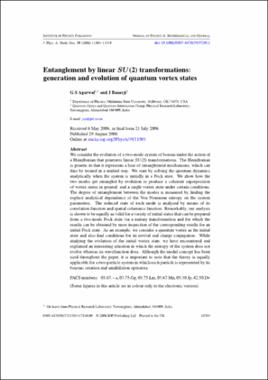| dc.contributor.author | Agarwal, G. S. | |
| dc.contributor.author | Banerji, J. | |
| dc.date.accessioned | 2015-10-16T20:47:25Z | |
| dc.date.available | 2015-10-16T20:47:25Z | |
| dc.date.issued | 2006-07-31 | |
| dc.identifier | okds_Agarwal_JPA_2006-07-31.pdf | |
| dc.identifier.citation | Agarwal, G. S., & Banerji, J. (2006). Entanglement by linear SU(2) transformations: Generation and evolution of quantum vortex states. Journal of Physics A: Mathematical and General, 39(37), 11503-11519. https://doi.org/10.1088/0305-4470/39/37/011 | |
| dc.identifier.uri | https://hdl.handle.net/11244/19718 | |
| dc.description.abstract | We consider the evolution of a two-mode system of bosons under the action of a Hamiltonian that generates linear SU(2) transformations. The Hamiltonian is generic in that it represents a host of entanglement mechanisms, which can thus be treated in a unified way. We start by solving the quantum dynamics analytically when the system is initially in a Fock state. We show how the two modes get entangled by evolution to produce a coherent superposition of vortex states in general, and a single vortex state under certain conditions. The degree of entanglement between the modes is measured by finding the explicit analytical dependence of the Von Neumann entropy on the system parameters. The reduced state of each mode is analyzed by means of its correlation function and spatial coherence function. Remarkably, our analysis is shown to be equally as valid for a variety of initial states that can be prepared from a two-mode Fock state via a unitary transformation and for which the results can be obtained by mere inspection of the corresponding results for an initial Fock state. As an example, we consider a quantum vortex as the initial state and also find conditions for its revival and charge conjugation. While studying the evolution of the initial vortex state, we have encountered and explained an interesting situation in which the entropy of the system does not evolve whereas its wave function does. Although the modal concept has been used throughout the paper, it is important to note that the theory is equally applicable for a two-particle system in which each particle is represented by its bosonic creation and annihilation operators. | |
| dc.format | application/pdf | |
| dc.language | en_US | |
| dc.publisher | IOP Publishing | |
| dc.rights | This material has been previously published. In the Oklahoma State University Library's institutional repository this version is made available through the open access principles and the terms of agreement/consent between the author(s) and the publisher. The permission policy on the use, reproduction or distribution of the material falls under fair use for educational, scholarship, and research purposes. Contact Digital Resources and Discovery Services at lib-dls@okstate.edu or 405-744-9161 for further information. | |
| dc.title | Entanglement by linear SU(2) transformations: Generation and evolution of quantum vortex states | |
| osu.filename | okds_Agarwal_JPA_2006-07-31.pdf | |
| dc.description.peerreview | Peer reviewed | |
| dc.identifier.doi | 10.1088/0305-4470/39/37/011 | |
| dc.description.department | Physics | |
| dc.type.genre | Article | |
| dc.type.material | Text | |
